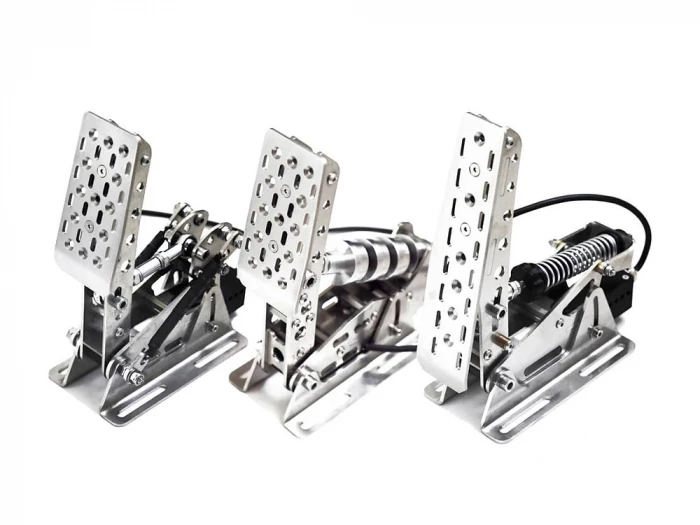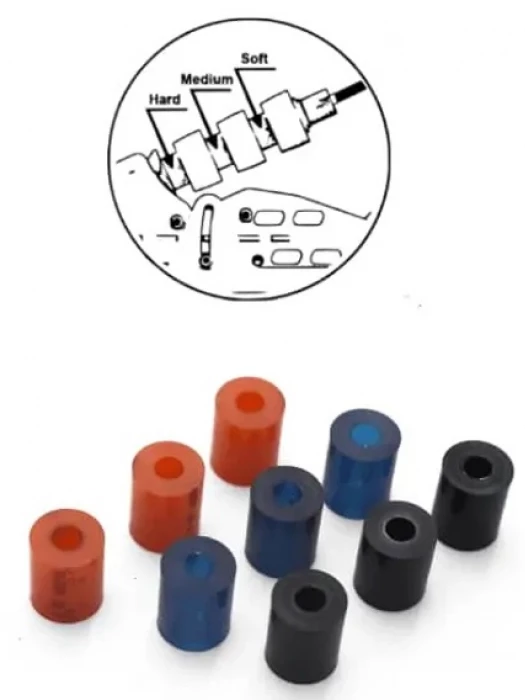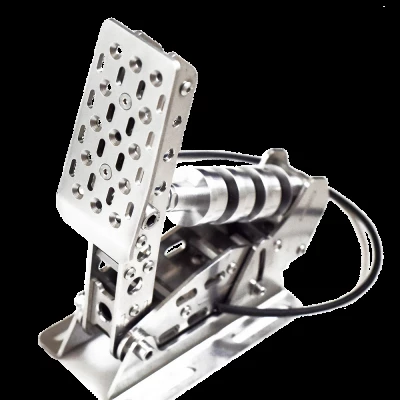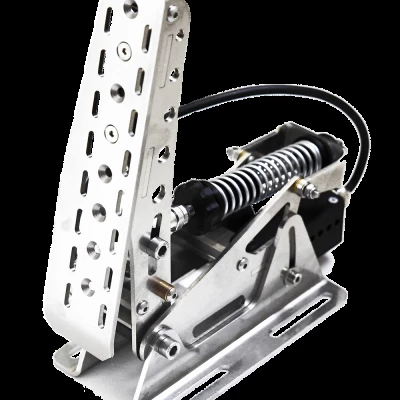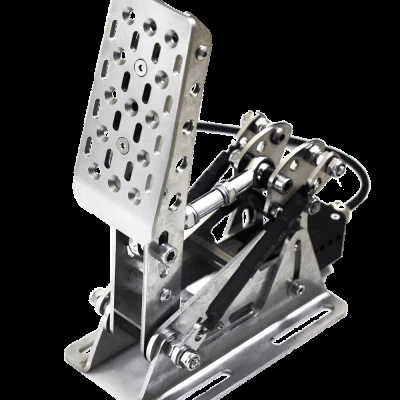MECA CUP 1 – 3 Pedal Set
MECA CUP 1 – 3 pedal set is equipped with a brake pedal with built-in "Load Cell" technology for ultra-precision braking in racing games, includes 3 mm thick stainless steel pedals and has adjustable pressure settings for each pedal. Made to last. Ultimate piece of sim racing hardware.
High quality 3mm thick stainless steel sim racing pedals with load cell technology.
THROTTLE PEDAL
Bronze slide bearings
Loadcell sensor
Board for signal conversion from loadcell (analogue-digital)
Solid construction, no unwanted movements or squeaks. Excellent response and feel and fully adjustable. Made to last using quality materials, electronics, and bronze machined components.
The shape and length of the pedals are adapted for the heel and toe technique. The pedal can be tilted forwards by loosening the rear screws in the round groove in the rear of the pedal. The grooves allow the pedal to tilt by 18°. The pedal height can be adjusted at the front part or by moving the rear's remote posts.
The pedal's stiffness can also be adjusted by moving the uni-ball in the pedal lever's groove (main stiffness setting), and fine-tuning the stiffness with the locking wheel pre-tensioning the spring.
The pedal surface is treated with ballotin (glass blasting), which increases adhesion.
BRAKE PEDAL
Loadcell sensor 200Kg
Bronze slide bearings
Aluminium brake segments
Three different hardness using replaceable polyurethane washers
The pedal can be adjusted both in height and longitude
Replaceable polyurethane rollers for pedal hardness adjustment
The brake pedal includes rollers of three levels of hardness: black – soft (pre-fitted to the pedal); blue – medium; orange – hard. Exchanging roller types between different hardness levels sets the feedback and feel of the braking system, and combining roller types affects the linearity of stiffness when pressing the pedal.
CLUTCH PEDAL
Bronze slide bearing
Loadcell sensor
Custom board for signal conversion from loadcell (analogue-digital)
Adjustable height and longitudinal position
As per the throttle pedal, this clutch pedal can be tilted forwards by loosening the rear screws in the round groove at the rear of the pedal, which allows the pedal to tilt by 18°; And the pedal surface is treated with ballotin (glass blasting), which increases adhesion.
The clutch pedal operates on a cradle principle with pre-tensioned springs. The system works by depressing the pedal along a predefined trajectory were at a given point the cradle tips over resulting in the reduction of pressure to the foot. Additionally, the pedal force can be adjusted by repositioning the pedal lever in its groove.
Another important benefit occurs when the polyurethane stoppers connect while fully pressing the brake pedal. When contact is made the brake simulates a pressurized brake system with no more pedal movement. This leads to a hard brake pedal resulting in a very similar feeling to breaking in a real car.
Pedals are equipped with a high-quality load cell sensors and supplied with aluminium polyurethane stoppers. Each polyurethane piece is equipped with its own stopper (aluminium bowl). This ensures that each polyurethane roller is protected against its marginal limit load and ensures the polyurethane rollers can be loaded until their weight limit. Once the limit is breached the rollers become kegs and the attached sensors are no longer capable of reading the force applied to the pedal as the force is expelled out of the axis. This design minimises excessive deformation, removes the unpleasant feeling of pedal-drop, and increases the roller's life expectancy. Stoppers prevent excessive deformation, significantly extend the lifespan of the polyurethanes, and contribute to an overall better braking feeling. Solid construction.
Handmade in Czech Republic.
For further technical information, you can email your enquiry to our specialist team and we will get back to you as soon as we can.
About Us
Race@home launched in 2020, offering immediate shipment of high-end sim hardware to frustrated customers. Our acclaimed LowRider 5DOF and new LowSlider 6DOF platforms prioritise compact excellence.
Contact Us
raceathome@gmail.com
+441163326679
Leicester, United Kingdom
WhatsApp
Instagram

